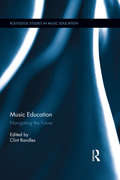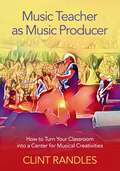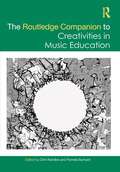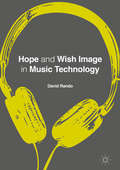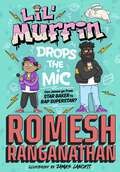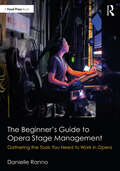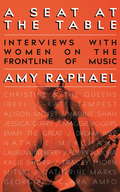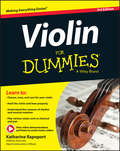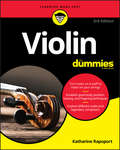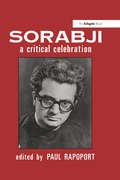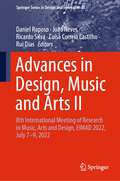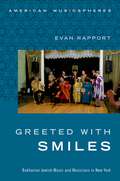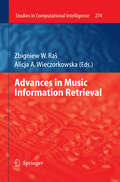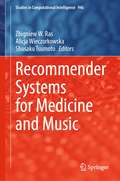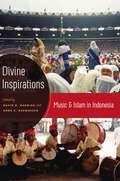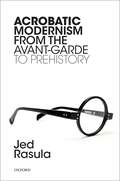- Table View
- List View
Music Education: Navigating the Future (Routledge Studies in Music Education #1)
by Clint RandlesEducation involving music is a multifaceted and ever-altering challenge. As new media, technologies, and pedagogies are developed, academics and practitioners must make sure that they are aware of current trends and where they might lead. This book features studies on the future of music education from emerging scholars in the field. These studies are then supplemented by commentaries from established leaders of the music education community. Music Education covers topics such as music and leisure, new forms of media in music teaching and learning, the role of technology in music learning, popular music tuition in the expansion of curricular offering, and assessment of music education research. As such, it is an excellent reference for scholars and teachers as well as guide to the future of the discipline.
Music Education: Navigating the Future (Routledge Studies in Music Education)
by Clint RandlesEducation involving music is a multifaceted and ever-altering challenge. As new media, technologies, and pedagogies are developed, academics and practitioners must make sure that they are aware of current trends and where they might lead. This book features studies on the future of music education from emerging scholars in the field. These studies are then supplemented by commentaries from established leaders of the music education community. Music Education covers topics such as music and leisure, new forms of media in music teaching and learning, the role of technology in music learning, popular music tuition in the expansion of curricular offering, and assessment of music education research. As such, it is an excellent reference for scholars and teachers as well as guide to the future of the discipline.
Music Teacher as Music Producer: How to Turn Your Classroom into a Center for Musical Creativities
by Clint RandlesNever has there been such an exciting time to be a music teacher. Band, choir, and orchestra are ubiquitous in schools and have come to be known as the primary mode that students experience music at the secondary level. Similarly, elementary school classrooms feature approaches by Orff, Kodaly, Dalcroze, and Music Learning Theory, among a host of others. But, what is next? In this enlightening guide, author Clint A. Randles provides music educators with the practical tools to turn their classrooms into student production studios. Addressing everything from a new conceptualization of the physical classroom space to the cables and other audio equipment no music educator should be without, Randles puts creativity, technology, recording arts, songwriting, music production, and live performance at the center of music classrooms.
Music Teacher as Music Producer: How to Turn Your Classroom into a Center for Musical Creativities
by Clint RandlesNever has there been such an exciting time to be a music teacher. Band, choir, and orchestra are ubiquitous in schools and have come to be known as the primary mode that students experience music at the secondary level. Similarly, elementary school classrooms feature approaches by Orff, Kodaly, Dalcroze, and Music Learning Theory, among a host of others. But, what is next? In this enlightening guide, author Clint A. Randles provides music educators with the practical tools to turn their classrooms into student production studios. Addressing everything from a new conceptualization of the physical classroom space to the cables and other audio equipment no music educator should be without, Randles puts creativity, technology, recording arts, songwriting, music production, and live performance at the center of music classrooms.
The Routledge Companion to Creativities in Music Education (Routledge Music Companions)
by Clint Randles Pamela BurnardViewing the plurality of creativity in music as being of paramount importance to the field of music education, The Routledge Companion to Creativities in Music Education provides a wide-ranging survey of practice and research perspectives. Bringing together philosophical and applied foundations, this volume draws together an array of international contributors, including leading and emerging scholars, to illuminate the multiple forms creativity can take in the music classroom, and how new insights from research can inform pedagogical approaches. In over 50 chapters, it addresses theory, practice, research, change initiatives, community, and broadening perspectives. A vital resource for music education researchers, practitioners, and students, this volume helps advance the discourse on creativities in music education.
Hope and Wish Image in Music Technology
by David P. RandoThis book proposes that new music technologies attract unconscious desires for socialism and collectivity, enabling millions of people living under capitalism to dream of repressed social alternatives. Grounded in the philosophical writings of Ernst Bloch and Walter Benjamin, the book examines file sharing technologies, streaming services, and media players, as well as their historical antecedents, such as the player piano, cassette tape, radio and compact disc, alongside interpretations of fiction, memoir, and albums. Through the concept of wish images—the unconscious hopes and desires for social alternatives that gather around new technologies—the book identifies the repressed pre- and post-capitalist urges that attend our music technologies. While these desires typically remain unconscious and tend to pass away not only unmet but also unrecognized, Hope and Wish Image in Music Technology attempts to bring wishes for social alternatives to the surface at an auspicious moment of technological transition.
Hope and Wish Image in Music Technology (PDF)
by David P. RandoThis book proposes that new music technologies attract unconscious desires for socialism and collectivity, enabling millions of people living under capitalism to dream of repressed social alternatives. Grounded in the philosophical writings of Ernst Bloch and Walter Benjamin, the book examines file sharing technologies, streaming services, and media players, as well as their historical antecedents, such as the player piano, cassette tape, radio and compact disc, alongside interpretations of fiction, memoir, and albums. Through the concept of wish images—the unconscious hopes and desires for social alternatives that gather around new technologies—the book identifies the repressed pre- and post-capitalist urges that attend our music technologies. While these desires typically remain unconscious and tend to pass away not only unmet but also unrecognized, Hope and Wish Image in Music Technology attempts to bring wishes for social alternatives to the surface at an auspicious moment of technological transition.
Lil' Muffin Drops the Mic: The brand-new children’s book from comedian Romesh Ranganathan!
by Romesh RanganathanFrom comedy superstar Romesh Ranganathan comes a hilarious and heartfelt tale that proves rap battles and baking muffins really can mix. The perfect story for readers age 8+ and fans of David Baddiel and Adam B Wins the Internet!Ever since his dad left, James can't seem to stop worrying about everything. His favourite hobby, baking, is a fun (and delicious!) distraction, but no matter how many AMAZING brownies he makes, James still feels like there's a missing ingredient in his life . . .Until he discovers rapping, and he's COMPLETELY hooked. It's not long before James starts writing his own raps about everything - from music and cakes to his giant pet rabbit, Graham!So when he hears that grime artist star Brukka is on the hunt for young talent, James starts to wonder: could this be his chance to share his MUFFINS, his MUSIC, and maybe even his feelings with the whole school? If he could only find the confidence . . .Full of laugh-out-loud illustrations from bestselling illustrator James Lancett, this is the children's read of the summer!
The Beginner’s Guide to Opera Stage Management: Gathering the Tools You Need to Work in Opera
by Danielle RannoThe Beginner’s Guide to Opera Stage Management is the first book to cover theatrical stage management practices specifically for opera productions, providing an invaluable step-by-step guide. Beginning with a brief history of opera and detailing its difference from musical theatre, the book covers stage management best practices through prep, rehearsals, tech, performance, and wrap up. From the moment a manager accepts a contract, right through to archiving paperwork, this essential toolkit covers each step of a stage manager’s journey. Working with a score, reading music, working with singers, conductors, and musicians, basic duties of a stage manager versus an assistant stage manager, and other tasks specific to opera are also included in this comprehensive guide. This book is full of tips and tricks, as well as the good, bad, and ugly stories from opera stage managers, sharing both their experiences and mistakes. This is the perfect how-to book for the professional or emerging stage manager looking to work in opera, or to expand their existing stage management skillset.
The Beginner’s Guide to Opera Stage Management: Gathering the Tools You Need to Work in Opera
by Danielle RannoThe Beginner’s Guide to Opera Stage Management is the first book to cover theatrical stage management practices specifically for opera productions, providing an invaluable step-by-step guide. Beginning with a brief history of opera and detailing its difference from musical theatre, the book covers stage management best practices through prep, rehearsals, tech, performance, and wrap up. From the moment a manager accepts a contract, right through to archiving paperwork, this essential toolkit covers each step of a stage manager’s journey. Working with a score, reading music, working with singers, conductors, and musicians, basic duties of a stage manager versus an assistant stage manager, and other tasks specific to opera are also included in this comprehensive guide. This book is full of tips and tricks, as well as the good, bad, and ugly stories from opera stage managers, sharing both their experiences and mistakes. This is the perfect how-to book for the professional or emerging stage manager looking to work in opera, or to expand their existing stage management skillset.
A Seat at the Table: Interviews with Women on the Frontline of Music
by Amy Raphael'Fascinating and illuminating' STYLIST'Perceptive and candid' IRISH TIMES'A fascinating, brilliant book, full of joy, rage, a love of music' THE SKINNY'Variously optimistic, troubling, joyful, illuminating, fierce and thoughtful' GUARDIANINTERVIEWS WITH WOMEN ON THE FRONTLINE OF MUSIC, from KATE TEMPEST to MAGGIE ROGERS, CHRISTINE AND THE QUEENS to IBEYI.Writer and critic Amy Raphael has interviewed some of the world's most iconic musicians, including Courtney Love, Patti Smith, Björk, Kurt Cobain and Elton John. In 1995 she wrote the critically-acclaimed Never Mind the Bollocks: Women Rewrite Rock, which included a foreword by Debbie Harry. More than two decades on, the music business has changed, but the way women are regarded has not. In this new book, A Seat at the Table, Raphael interviews eighteen women who work in the music industry about learning to speak out, #MeToo, social media, queer politics and the subtleness of everyday misogyny. Featuring interviews with:CHRISTINE & THE QUEENSIBEYI KATE TEMPESTALISON MOYETNADINE SHAHJESSICA CURRYMAGGIE ROGERSEMMY THE GREATDREAM WIFENATALIE MERCHANTLAUREN MAYBERRYPOPPY AJUDHAKALIE SHORRTRACEY THORNMITSKICATHERINE MARKS GEORGIACLARA AMFO
Violin For Dummies
by Katharine RapoportThe beginner's guide to learning the violin — for any musical style Violin For Dummies helps you teach yourself to play the violin, even if you've never read a note of music. From choosing the right violin for you to playing a variety of musical styles, this book has you covered. You'll start with the basics of posture and bowing technique, learn how to tune your instrument and keep it in beautiful condition with regular maintenance. You'll learn how to read — and feel — the music, and how to inject your own personality into whatever you play. Before you know it, you'll be playing classical, jazz, country, and more, as you become a bona fide violin player. The included audio and video instruction encourages you to play along as you learn, and allow you to hear, see, and imitate proper technique. The violin's small size, portability, and mimicry of the human voice have made it popular across cultures and throughout time. This book shows you how to teach yourself the basics so you can start playing quickly. Start with the basics of proper hold and bowing technique Learn how to properly tune and care for your violin Understand the nuances of rhythm and musical notation Play classical, jazz, and other popular styles of music The violin has a reputation of being difficult to learn, but the reality is that it's difficult to master. Anyone can learn, and practice over time will refine your technique and your musical style. You'll have fun, make music, and maybe even fall in love with this instrument that has inspired some of the world's best musicians and composers. Get started today, the easy way, with Violin For Dummies.
Violin For Dummies
by Katharine RapoportThe beginner's guide to learning the violin — for any musical style Violin For Dummies helps you teach yourself to play the violin, even if you've never read a note of music. From choosing the right violin for you to playing a variety of musical styles, this book has you covered. You'll start with the basics of posture and bowing technique, learn how to tune your instrument and keep it in beautiful condition with regular maintenance. You'll learn how to read — and feel — the music, and how to inject your own personality into whatever you play. Before you know it, you'll be playing classical, jazz, country, and more, as you become a bona fide violin player. The included audio and video instruction encourages you to play along as you learn, and allow you to hear, see, and imitate proper technique. The violin's small size, portability, and mimicry of the human voice have made it popular across cultures and throughout time. This book shows you how to teach yourself the basics so you can start playing quickly. Start with the basics of proper hold and bowing technique Learn how to properly tune and care for your violin Understand the nuances of rhythm and musical notation Play classical, jazz, and other popular styles of music The violin has a reputation of being difficult to learn, but the reality is that it's difficult to master. Anyone can learn, and practice over time will refine your technique and your musical style. You'll have fun, make music, and maybe even fall in love with this instrument that has inspired some of the world's best musicians and composers. Get started today, the easy way, with Violin For Dummies.
Violin For Dummies: Book + Online Video and Audio Instruction
by Katharine RapoportTurn notes on a staff to notes on your strings Establish good body position, bowing, and fingering techniques Explore different styles and legendary composers Draw beautiful sounds from your violin! While learning the violin is a formidable goal, you don't have to be a music genius to grasp the basics. And with practice, the payoff will be music to your ears—plus a world of musical opportunity. This book starts you on the path to mastering the instrument that is central to musical cultures throughout the world. Playing along with the lessons in this friendly step-by-step guide will take you from first notes to performing entire songs—and you'll be glad you added this string to your bow! Inside... Choose your instrument Hold your violin correctly Play scales and chords Understand notation Master different music styles Tune and care for your instrument Find practice files online
Violin For Dummies: Book + Online Video and Audio Instruction
by Katharine RapoportTurn notes on a staff to notes on your strings Establish good body position, bowing, and fingering techniques Explore different styles and legendary composers Draw beautiful sounds from your violin! While learning the violin is a formidable goal, you don't have to be a music genius to grasp the basics. And with practice, the payoff will be music to your ears—plus a world of musical opportunity. This book starts you on the path to mastering the instrument that is central to musical cultures throughout the world. Playing along with the lessons in this friendly step-by-step guide will take you from first notes to performing entire songs—and you'll be glad you added this string to your bow! Inside... Choose your instrument Hold your violin correctly Play scales and chords Understand notation Master different music styles Tune and care for your instrument Find practice files online
Sorabji: A Critical Celebration
by Paul RapoportKaikhosru Shapurji Sorabji (1892-1988) was an unusual legend in his own lifetime: a Parsi composer and critic living in England whose compositions are of such length and difficulty that he felt compelled to ban public performances of them. This book, the first devoted to Sorabji, explores his life and character, his music, his articles and letters. It both presents the legend accurately and dispels its exaggerated aspects. The portrait which emerges is not of a crank or eccentric but of a highly original and accomplished musical thinker whom recent performances and recordings confirm as unique and important. Most of the contributors knew Sorabji personally. They have all written about or performed his music, gaining international recognition for their work. Generous quotation of Sorabji's published and unpublished music and prose assists in bringing him and his work strikingly to life. The book also contains the most complete and accurate register of his work ever published.
Sorabji: A Critical Celebration
by Paul Rapoport Alistair Hinton Frank Holliday Kenneth Derus Nazlin Bhimani Michael Habermann Geoffrey Douglas Madge Marc-André RobergeKaikhosru Shapurji Sorabji (1892-1988) was an unusual legend in his own lifetime: a Parsi composer and critic living in England whose compositions are of such length and difficulty that he felt compelled to ban public performances of them. This book, the first devoted to Sorabji, explores his life and character, his music, his articles and letters. It both presents the legend accurately and dispels its exaggerated aspects. The portrait which emerges is not of a crank or eccentric but of a highly original and accomplished musical thinker whom recent performances and recordings confirm as unique and important. Most of the contributors knew Sorabji personally. They have all written about or performed his music, gaining international recognition for their work. Generous quotation of Sorabji's published and unpublished music and prose assists in bringing him and his work strikingly to life. The book also contains the most complete and accurate register of his work ever published.
Advances in Design, Music and Arts II: 8th International Meeting of Research in Music, Arts and Design, EIMAD 2022, July 7–9, 2022 (Springer Series in Design and Innovation #25)
by Daniel Raposo João Neves Ricardo Silva Luísa Correia Castilho Rui DiasThis book presents cutting-edge methods and findings that are expected to contribute to significant advances in the areas of communication design, fashion design, interior design and product design, as well as musicology and other related areas. It especially focuses on the role of digital technologies, and on strategies fostering creativity, collaboration, education, as well as sustainability and accessibility in the broadly-intended field of design. Gathering the proceedings of the 8th EIMAD conference, held on July 7–9, 2022, and organized by the School of Applied Arts of the Instituto Politécnico de Castelo Branco, in Portugal, this book offers a timely guide and a source of inspiration for designers of all kinds, advertisers, artists, and entrepreneurs, as well as educators and communication managers.
Greeted With Smiles: Bukharian Jewish Music and Musicians in New York (American Musicspheres)
by Evan RapportAs the Soviet Union stood on the brink of collapse, thousands of Bukharian Jews left their homes from across the predominantly Muslim cities of Central Asia, to reestablish their lives in the United States, Israel and Europe. Today, about thirty thousand Bukharian Jews reside in New York City, settled into close-knit communities and existing as a quintessential American immigrant group. For Bukharian immigrants, music is an essential part of their communal self-definition, and musicians frequently act as cultural representatives for the group as a whole. Greeted with Smiles: Bukharian Jewish Music and Musicians in New York explores the circumstances facing new American immigrants, using the music of the Bukharian Jews to gain entrance into their community and their culture. Author Evan Rapport investigates the transformation of Bukharian identity through an examination of corresponding changes in its music, focusing on three of these distinct but overlapping repertoires - maqom (classical or "heavy" music), Jewish religious music and popular party (or "light") music. Drawing upon interviews, participant observation and music lessons, Rapport interprets the personal perspectives of musicians who serve as community leaders and representatives. By adapting strategies acquired as an ethno-religious minority among Central Asian Muslim neighbors, Bukharian musicians have adjusted their musical repertoire in their new American home. The result is the creation of a distinct Bukharian Jewish American identity-their musical activities are changing the city's cultural landscape while at the same time providing for an understanding of the cultural implications of Bukharian diaspora. Greeted with Smiles is sure to be an essential text for ethnomusicologists and scholars of Jewish and Central Asian music and culture, Jewish-Muslim interaction and diasporic communities.
Greeted With Smiles: Bukharian Jewish Music and Musicians in New York (American Musicspheres)
by Evan RapportAs the Soviet Union stood on the brink of collapse, thousands of Bukharian Jews left their homes from across the predominantly Muslim cities of Central Asia, to reestablish their lives in the United States, Israel and Europe. Today, about thirty thousand Bukharian Jews reside in New York City, settled into close-knit communities and existing as a quintessential American immigrant group. For Bukharian immigrants, music is an essential part of their communal self-definition, and musicians frequently act as cultural representatives for the group as a whole. Greeted with Smiles: Bukharian Jewish Music and Musicians in New York explores the circumstances facing new American immigrants, using the music of the Bukharian Jews to gain entrance into their community and their culture. Author Evan Rapport investigates the transformation of Bukharian identity through an examination of corresponding changes in its music, focusing on three of these distinct but overlapping repertoires - maqom (classical or "heavy" music), Jewish religious music and popular party (or "light") music. Drawing upon interviews, participant observation and music lessons, Rapport interprets the personal perspectives of musicians who serve as community leaders and representatives. By adapting strategies acquired as an ethno-religious minority among Central Asian Muslim neighbors, Bukharian musicians have adjusted their musical repertoire in their new American home. The result is the creation of a distinct Bukharian Jewish American identity-their musical activities are changing the city's cultural landscape while at the same time providing for an understanding of the cultural implications of Bukharian diaspora. Greeted with Smiles is sure to be an essential text for ethnomusicologists and scholars of Jewish and Central Asian music and culture, Jewish-Muslim interaction and diasporic communities.
Advances in Music Information Retrieval (Studies in Computational Intelligence #274)
by Zbigniew W. Ras Alicja WieczorkowskaSound waves propagate through various media, and allow communication or entertainment for us, humans. Music we hear or create can be perceived in such aspects as rhythm, melody, harmony, timbre, or mood. All these elements of music can be of interest for users of music information retrieval systems. Since vast music repositories are available for everyone in everyday use (both in private collections, and in the Internet), it is desirable and becomes necessary to browse music collections by contents. Therefore, music information retrieval can be potentially of interest for every user of computers and the Internet. There is a lot of research performed in music information retrieval domain, and the outcomes, as well as trends in this research, are certainly worth popularizing. This idea motivated us to prepare the book on Advances in Music Information Retrieval. It is divided into four sections: MIR Methods and Platforms, Harmony, Music Similarity, and Content Based Identification and Retrieval. Glossary of basic terms is given at the end of the book, to familiarize readers with vocabulary referring to music information retrieval.
Recommender Systems for Medicine and Music (Studies in Computational Intelligence #946)
by Zbigniew W. Ras Alicja Wieczorkowska Shusaku TsumotoMusic recommendation systems are becoming more and more popular. The increasing amount of personal data left by users on social media contributes to more accurate inference of the user’s musical preferences and the same to quality of personalized systems. Health recommendation systems have become indispensable tools in decision making processes in the healthcare sector. Their main objective is to ensure the availability of valuable information at the right time by ensuring information quality, trustworthiness, authentication, and privacy concerns. Medical doctors deal with various kinds of diseases in which the music therapy helps to improve symptoms. Listening to music may improve heart rate, respiratory rate, and blood pressure in people with heart disease. Sound healing therapy uses aspects of music to improve physical and emotional health and well-being. The book presents a variety of approaches useful to create recommendation systems in healthcare, music, and in music therapy.
Divine Inspirations: Music and Islam in Indonesia
by Anne K. Rasmussen David D. HarnishDivine Inspirations: Music and Islam in Indonesia brings together the work of 11 international scholars into an unprecedented volume focused on religion and performance in a nation celebrated for its extraordinary arts, religious diversity, and natural beauty. The resulting collection provides a panoramic view of Indonesia's Islamic arts in a variety of settings and communities. Together the authors address how history, politics, spirituality, and gender are expressed through performance and how Indonesian Islamic culture intersects with the ideology and practice of nationalism. Unique and engaging, Divine Inspirations will fascinate readers interested in Southeast Asia, the Middle East, Islam, world religions, global discourse, and music, arts and ritual.
Acrobatic Modernism from the Avant-Garde to Prehistory
by Jed RasulaThis is a book about artistic modernism contending with the historical transfigurations of modernity. As a conscientious engagement with modernity's restructuring of the lifeworld, the modernist avant-garde raised the stakes of this engagement to programmatic explicitness. But even beyond the vanguard, the global phenomenon of jazz combined somatic assault with sensory tutelage. Jazz, like the new technologies of modernity, re-calibrated sensory ratios. The criterion of the new as self-making also extended to names: pseudonyms and heteronyms. The protocols of modernism solicited a pragmatic arousal of bodily sensation as artistic resource, validating an acrobatic sensibility ranging from slapstick and laughter to the pathos of bereavement. Expressivity trumped representation. The artwork was a diagram of perception, not a mimetic rendering. For artists, the historical pressures of altered perception provoked new models, and Ezra Pound's slogan 'Make It New' became the generic rallying cry of renovation. The paradigmatic stance of the avant-garde was established by Futurism, but the discovery of prehistoric art added another provocation to artists. Paleolithic caves validated the spirit of all-over composition, unframed and dynamic. Geometric abstraction, Constructivism and Purism, and Surrealism were all in quest of a new mythology. Making it new yielded a new pathos in the sensation of radical discrepancy between futurist striving and remotest antiquity. The Paleolithic cave and the USSR emitted comparable siren calls on behalf of the remote past and the desired future. As such, the present was suffused with the pathos of being neither, but subject to both.
Acrobatic Modernism from the Avant-Garde to Prehistory
by Jed RasulaThis is a book about artistic modernism contending with the historical transfigurations of modernity. As a conscientious engagement with modernity's restructuring of the lifeworld, the modernist avant-garde raised the stakes of this engagement to programmatic explicitness. But even beyond the vanguard, the global phenomenon of jazz combined somatic assault with sensory tutelage. Jazz, like the new technologies of modernity, re-calibrated sensory ratios. The criterion of the new as self-making also extended to names: pseudonyms and heteronyms. The protocols of modernism solicited a pragmatic arousal of bodily sensation as artistic resource, validating an acrobatic sensibility ranging from slapstick and laughter to the pathos of bereavement. Expressivity trumped representation. The artwork was a diagram of perception, not a mimetic rendering. For artists, the historical pressures of altered perception provoked new models, and Ezra Pound's slogan 'Make It New' became the generic rallying cry of renovation. The paradigmatic stance of the avant-garde was established by Futurism, but the discovery of prehistoric art added another provocation to artists. Paleolithic caves validated the spirit of all-over composition, unframed and dynamic. Geometric abstraction, Constructivism and Purism, and Surrealism were all in quest of a new mythology. Making it new yielded a new pathos in the sensation of radical discrepancy between futurist striving and remotest antiquity. The Paleolithic cave and the USSR emitted comparable siren calls on behalf of the remote past and the desired future. As such, the present was suffused with the pathos of being neither, but subject to both.
